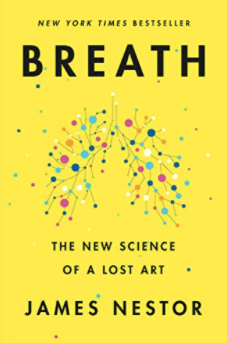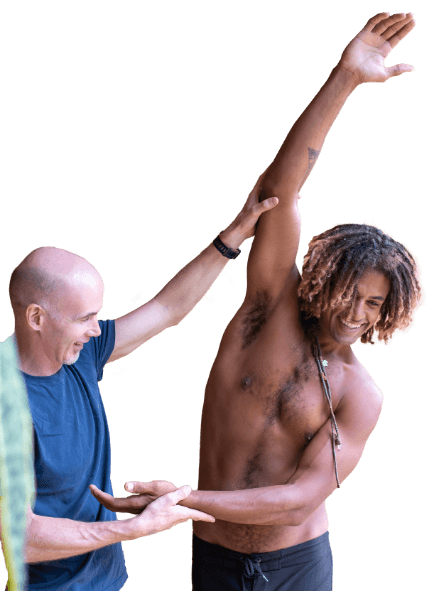
I recently read “Breath: The New Science of a Lost Art” by James Nestor.
He decided to write the book after his interest was peaked when he wrote a book on freediving. Obviously free divers take breath work to another level but he also heard of the following things:
– An Indian doctor lost weight just by changing his breathing.
– Wim Hof, the Dutchman that can control the reaction of his immune system potentially giving hope to suffers of rheumatoid arthritis and other autoimmune diseases.
– A women who had put her cancer into remission
– Monks who could give off so much heat when they breath they could melt the snow around them.
– 90% of us are breathing in a way that causes or exacerbates health issues like asthma, psoriasis, ADHD and anxiety.
So he decided to investigate
It starts in the Face
In modern times our face has undergone some significant changes. Our faces have got longer and our airways have narrowed. This could be due to change in climate or the development of our voice box but interestingly researchers have noticed this happening within one or two generations. In the 1930’s Weston A Price, a dentist for the USA, travelled to many indigenous cultures and noticed that most of them had perfect arches, open sinuses and strong feet. He found this in stark contradiction to the narrow palates, blocked sinuses and flat feet that he saw back in the USA. He decided to follow these families for a few generations and what he found was truly remarkable. He noticed that when the children of the people he originally studied where exposed to a ‘western diet’ one that contained refined grains and suga,r their palate narrowed and their sinuses became smaller. He also managed to study twins, one of whom went to the city and ate refined foods and the other who stayed eating traditional foods. It turned out that the one in the city developed a narrower palate! All this is out lined in his seminal work “Nutrition and Physical Degeneration”
https://www.amazon.ca/Nutrition-Physical-Degeneration-Weston-Price/dp/0916764206
How can this be explained?
One theory is that as the food it softer we don’t stimulate our jaw and the associated muscles and over time the bones tend to thin. Nestor decided to test this, but the other way round. He found a dentist in the UK called Dr Belfor who fitted him with a mouth expanding device called a Hemeoblock. He took x-rays before and 1 week after wearing the device (which essentially stimulates the jaw) and there was already noticeable bone growth around his cheeks, right eye socket, nose and upper jaw. But most importantly for the author his sinus infection disappeared.
What type of breathing is best?
As with all the best questions it gets the best answer…it depends. Back in 1981 Herbert Benson, a Harvard researcher travelled to the Himalayas to run some experiments on monks that were practitioners of Tummo breathing. He found that they could raise the temperature in their extremities by up to 17degrees.
More recently the Dutch endurance athlete, Wim Hof has taken Tummo breathing and made it his own. This style of breathing involves deep breathing for 3 sets of 30 repetitions of deep breathing followed by breathing out and holding as long as you can. When the urge to breath in overpowers you then breathe in and hold for about 10 sec (repeat 3 times). Using this method Wim has successfully altered the response of his nervous system so that he doesn’t suffer from the unpleasant side effects of immune reactions, namely headaches, runny nose, sore throat etc. It should be noted though that he does combine his breath work with cold exposure he also holds a world record or 2 for cold exposure.
How does altering your breathing work?
There are different researchers all round the world looking at the effect of carbon dioxide on the body. We all know that it is a waste product and needs to be released from the body but releasing too much, as in hyperventilation, can cause problems. Conversely, releasing too little by breathing shallowly can also cause problems. However, through the use of breath holds researchers have been able to help people manage their panic attacks. Imagine the image of someone breathing into a paper back to calm down a panic attack. At the other end of the spectrum athletes are experimenting with adding carbon dioxide to their air, at just the right amount, to stimulate their brain’s chemoreceptors (the part of the brain that tells you to breathe). They have found that doing this can increase stamina. One of the reasons for this is when carbon dioxide levels are high it opens blood vessels allowing, surprisingly, more oxygen into the tissues. Also, blood slightly higher in carbon dioxide did a better job of releasing oxygen molecules. By contrast too much oxygen a rapid heart rate and muscle wasting. Nestor experimented on himself and showed that if he breathed slower his blood oxygen levels actually increased!
For me one of the most interesting parts of the book was the main experiment that James did on himself and a colleague. They plugged their noses for 10 days and just breathed through their mouths. We all know mouth breathers, right? Well this is what happened to him in just 10 days.
 The-Breath-Training-The-MW-Cheatsheet
The-Breath-Training-The-MW-Cheatsheet
Over the last 10 years Ed has been building a YouTube library to help people manage their own pain or movement limitations and increase performance through exercise. He regularly adds videos so be sure to subscribe and visit regularly


"Oh My Gosh- I am ALREADY feeling relief after a few days! I used to wake up 2-3 times a night with shooting pain that anti inflammatories couldn't touch. Now I have been waking up just because I want to notice what it feels like to lay in bed pain free- THANK YOU!."

"When I first started with your program I was experience a lot of pain. Walking was difficult. I had to stop and catch my breath every few minutes and lean against a wall for support. Now when I walk with my husband we go for over an hour. I never had to sit down and stop...and, hardly any pain!!! 😊😊 I can’t thank you enough."
Frustrated that you aren't recovering fast enough?
Discover how to heal from illness and injury using movement, food and lifestyle.
Leave a Reply